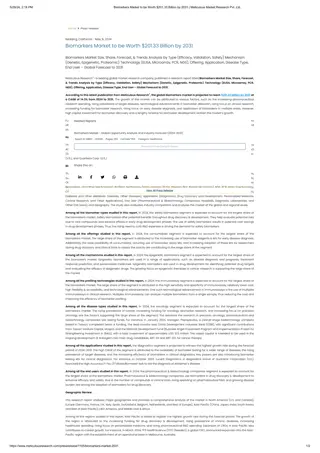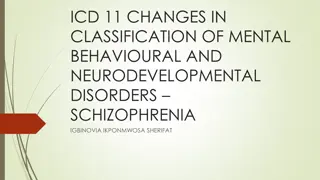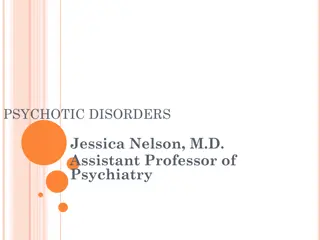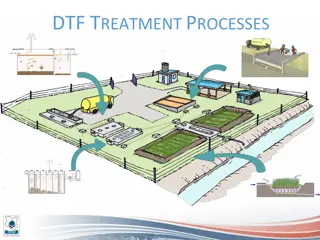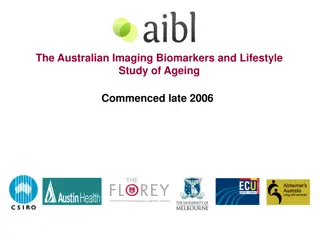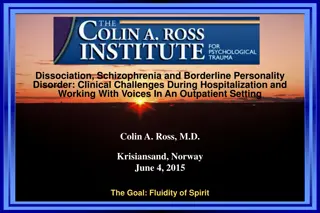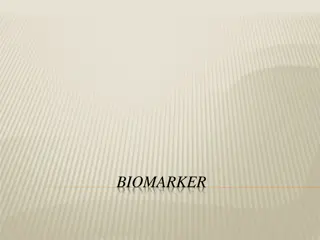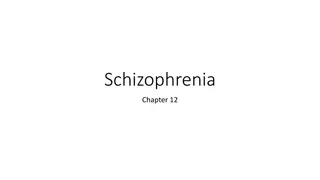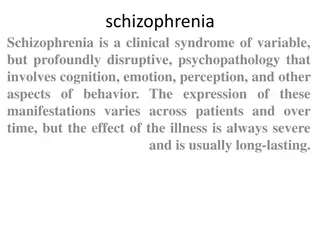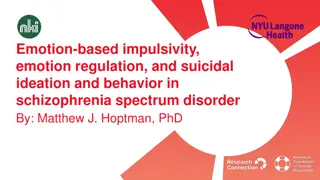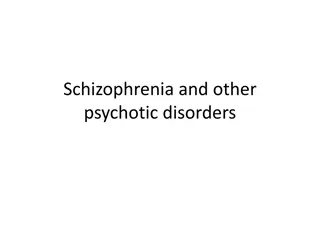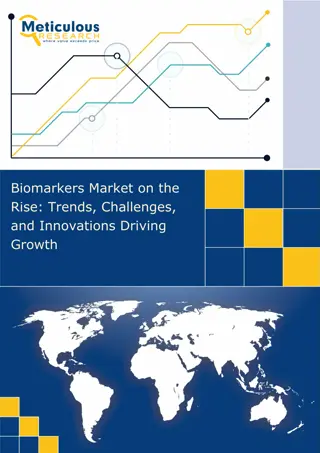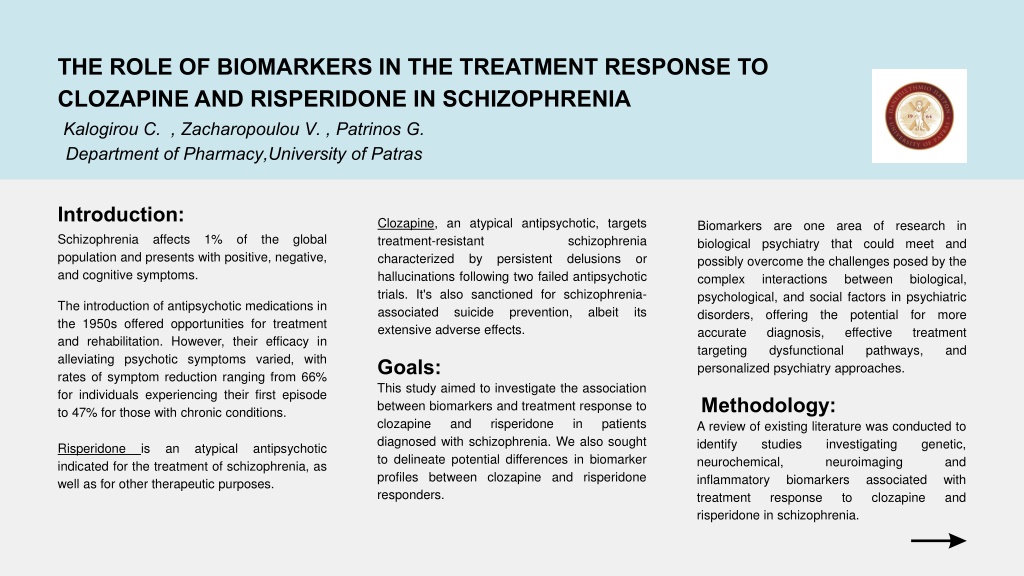
Biomarkers in Clozapine and Risperidone Treatment Response for Schizophrenia
Explore the role of biomarkers in predicting treatment response to clozapine and risperidone in schizophrenia. Learn about genetic biomarkers and miRNAs, such as miR-132 and miR-134, potentially indicating response to antipsychotic medication. Discover how hyperprolactinemia and genetic variants influence treatment outcomes. This study delves into the intricate relationship between biomarkers and personalized psychiatry approaches for better schizophrenia management.
Download Presentation

Please find below an Image/Link to download the presentation.
The content on the website is provided AS IS for your information and personal use only. It may not be sold, licensed, or shared on other websites without obtaining consent from the author. Download presentation by click this link. If you encounter any issues during the download, it is possible that the publisher has removed the file from their server.
E N D
Presentation Transcript
THE ROLE OF BIOMARKERS IN THE TREATMENT RESPONSE TO CLOZAPINE AND RISPERIDONE IN SCHIZOPHRENIA Kalogirou C. , Zacharopoulou V. , Patrinos G. Department of Pharmacy,University of Patras Introduction: Clozapine, an atypical antipsychotic, targets treatment-resistant characterized by persistent delusions or hallucinations following two failed antipsychotic trials. It's also sanctioned for schizophrenia- associated suicide prevention, extensive adverse effects. Biomarkers are one area of research in biological psychiatry that could meet and possibly overcome the challenges posed by the complex interactions psychological, and social factors in psychiatric disorders, offering the potential for more accurate diagnosis, targeting dysfunctional personalized psychiatry approaches. Schizophrenia affects 1% of the global population and presents with positive, negative, and cognitive symptoms. schizophrenia between biological, The introduction of antipsychotic medications in the 1950s offered opportunities for treatment and rehabilitation. However, their efficacy in alleviating psychotic symptoms varied, with rates of symptom reduction ranging from 66% for individuals experiencing their first episode to 47% for those with chronic conditions. albeit its effective pathways, treatment and Goals: This study aimed to investigate the association between biomarkers and treatment response to clozapine and risperidone diagnosed with schizophrenia. We also sought to delineate potential differences in biomarker profiles between clozapine and risperidone responders. Methodology: in patients A review of existing literature was conducted to identify studies investigating neurochemical, neuroimaging inflammatory biomarkers treatment response risperidone in schizophrenia. genetic, and with and Risperidone indicated for the treatment of schizophrenia, as well as for other therapeutic purposes. is an atypical antipsychotic associated clozapine to
Results miRNAs Hyperprolactinemia MiRNAs are small non-coding RNA molecules that post-transcriptionally regulate gene expression by binding to the 3' untranslated region of target mRNAs, leading to mRNA degradation or translational repression. They play essential roles in various biological processes, including neuronal development, synaptic plasticity, and neurotransmitter signaling. Dysregulation of miRNA expression has been implicated in the pathophysiology of psychiatric disorders, making them attractive targets for biomarker discovery. For instance, a study found that upregulation of miR-132 and downregulation of miR-134 were associated with better response to risperidone in patients with schizophrenia. (Yu H. C et al. 2015 )Similarly, Yu Funahashi et al. (2023) reported that global miRNA changes in plasma EXO derived from patients with SCZ that were relevant to neuronal functions, among which, hsa-miR-675-3p expression was upregulated by clozapine treatment. These findings suggest that miRNA expression profiles may serve as biomarkers for predicting individual response to antipsychotic medications. Hyperprolactinemia can arise from antipsychotic drugs binding to dopamine D2 receptors. Medications like risperidone and amisulpride, with strong D2 binding, significantly elevate prolactin (PRL) levels, while olanzapine induces modest increases; however, clozapine and quetiapine, with lower D2 binding, do not cause hyperprolactinemia. A prospective study involving 102 schizophrenia patients found that a prolactin increase of over 20% indicated a better response to risperidone therapy.(Alladi Charan et al., 2016) On the other hand a study in 27 acute psychotic inpatients who completed a 12 week trial of risperidone, concluded that the changes in serum PRL levels were not significantly correlated with clinical efficacy of risperidone.(Bun-Hee Lee et al., 2006) Genetic biomarkers Pharmacogenomic studies have identified specific genetic biomarkers associated with treatment response to risperidone and clozapine. For instance, Wang X. et al. (2024) found that genetic variants in the CYP2D6 gene were predictive of individual differences in plasma levels of risperidone and its active metabolite, as well as treatment response and tolerability. Similarly, Arranz MJ et. (1998) reported associations between genetic polymorphisms in serotonin receptor genes and clozapine response in patients with schizophrenia.
Results (2) Neuroimaging techniques Neuroimaging stands out as a promising avenue for biomarker advancement in schizophrenia. It provides flexibility in assessing various pathophysiological mechanisms, encompassing deficits in brain structural integrity, functional connectivity, and disruptions in neurotransmitter systems. Neurochemical imaging techniques, including magnetic resonance spectroscopy (MRS) and PET imaging with radiotracers targeting specific neurotransmitter systems, offer insights into the neurochemical changes associated with treatment response. Studies have investigated alterations in gamma-aminobutyric acid (GABA), glutamate, and dopamine levels in response to risperidone and clozapine treatment. These neurochemical changes may serve as biomarkers of treatment response and could potentially inform treatment selection and optimization.For instance, changes in the default mode network (DMN) connectivity or striatal dopamine receptor occupancy have been linked to treatment response in schizophrenia patients receiving these medications. The dopamine D2 receptor The glutamate/GABA system Antipsychotic medications produce therapeutic and adverse effects by antagonizing the dopamine D2 receptor (DRD2). Variations in genetic forms of this receptor may account for individual differences in response to neuroleptic drugs and could be valuable in forecasting treatment outcomes. A research conducted in 125 schizophrenic in-patients found that genetic variations in the dopamine D2 receptor influence responses to antipsychotic drugs like risperidone. The A-241G polymorphism in the DRD2 promoter was linked to therapeutic outcomes in those patients. Carriers of the x241A allele responded better to risperidone, but further studies with larger samples are needed for conclusive evidence.(Qinghe Xing et al., 2007) The dysregulation of the glutamate/GABA system in schizophrenia is increasingly recognized alongside dopaminergic dysfunction, with several studies implicating elevated glutamate levels in treatment resistance. Higher glutamate metabolite levels, particularly in the anterior cingulate cortex, are associated with poorer antipsychotic responses and adverse effects upon re- initiating antipsychotic therapy. Additionally, the involvement of inhibitory GABAergic system dysfunction, schizophrenia, suggests its role in cognitive impairment, underscoring the complex interplay between neurotransmitter systems in schizophrenia pathophysiology. Furthermore, investigations into specific genes such as GRIN2B, GRM3, GAD1, and GABBR2 provide insights into potential genetic markers and their associations with treatment resistance, warranting further research to elucidate their roles in schizophrenia treatment response.(Jiao et al., 2022) particularly in treatment-resistant
Results(3) Brain-derived neurotrophic factor Inflammation Treatment-resistant schizophrenia (TRS) refers to the lack of response to at least two first-line antipsychotic treatments, affecting around 30% of schizophrenia patients. Clozapine (CLZ) is the only evidence-based treatment for TRS, but its use is delayed. Ultra TRS (UTRS) involves cases failing to respond to CLZ and represents a significant subgroup within TRS patients. About 30% of schizophrenia patients refractory to antipsychotics have only clozapine as a treatment option, yet its mechanism of action remains unclear, and there are currently no biomarkers to forecast a favorable response to the medication. Brain-derived neurotrophic factor (BDNF) plays a vital role in the generation and growth of neural pathways during development. BDNF, a crucial neurotrophin, is extensively studied in schizophrenia pathophysiology and response to antipsychotic treatment. Brain BDNF is linked to schizophrenia, with serum levels correlating with brain BDNF levels. The research of Krivoy et al., (2018) indicates that individuals who responded positively to cloazapine treatment exhibited elevated serum BDNF levels in contrast to those who did not respond. Current hypotheses suggest that treatment-resistant schizophrenia (TRS) may stem from differences in dopamine functioning, alterations in glutamate levels, or disruptions in other pathways, with inflammation emerging as a key contributor to resistance. Elevated levels of inflammation, indicated by increased cytokine levels in peripheral blood and cerebrospinal fluid, particularly characterize TRS, with neuroinflammation in early life potentially contributing to TRS development. The frequency of treatment-resistant schizophrenia (TRS) and ultra-treatment- resistant schizophrenia (UTRS) patients was 20% and 7.7%, respectively, defined by elevated levels of interleukin (IL)-12/IL-23p40, IL-17A, IL-10, and beta 2 microglobulin (B2M) for TRS, and IL-12/IL-23p40, IL-17A, IL-6, IL-10, IFN , and B2M for UTRS. These findings suggest that TRS and UTRS may be associated with pro-inflammatory molecules, particularly from the T helper 17 pathway, highlighting the potential of the IL-23/IL-17 pathway as a therapeutic target for antipsychotic-resistant patients. (Leboyer M. et al. 2021) Metabolic biomarkers Several studies have investigated metabolic biomarkers associated with treatment response to risperidone and clozapine. For example, Tsai HP et al., (2021) found that changes in plasma levels of glucose, insulin, and lipid metabolites were predictive of treatment response in patients receiving risperidone. Similarly,Procyshyn RM et. al (2007) reported that alterations in serum levels of certain amino acids and lipid species were associated with treatment response to clozapine. These findings suggest that metabolic profiling may offer valuable insights into the mechanisms underlying individual differences in treatment response.
Discussion: References: In exploring the role of biomarkers in the treatment response to clozapine and risperidone in schizophrenia, it becomes evident that various biological factors contribute to medication efficacy and adverse effects. 1. Yu H. C., Wu J., Zhang H. X., Zhang G. L., et al. (2015). Alterations of miR-132 are novel diagnostic biomarkers in peripheral blood of schizophrenia patients. Prog. Neuropsychopharmacol. Biol. Psychiatry 63 23 29. 2. Yu Funahashi, Yuta Yoshino, Jun-ichi Iga & Shu-ichi Ueno (2023). Impact of clozapine on the expression of miR- 675-3p in plasma exosomes derived from patients with schizophrenia, The World Journal of Biological Psychiatry, 24:4, 303-313. 3. Alladi Charan, Deepak Gopal Shewade, Ravi Philip Rajkumar et. al. (2016). Relation between serum prolactin levels and antipsychotic response to risperidone in patients with schizophrenia, Psychiatry Research, Volume 240, 2016, Pages 209-213. 4. Bun-Hee Lee, Yong-Ku Kim et al. The relationship between prolactin response and clinical efficacy of risperidone in acute psychotic inpatients, Progress in Neuro-Psychopharmacology and Biological Psychiatry, Volume 30, Issue 4, 2006, Pages 658-662. 5. Wang X, Huang J, Lu J, et al. Risperidone plasma level, and its correlation with CYP2D6 gene polymorphism, clinical response and side effects in chronic schizophrenia patients. BMC Psychiatry. 2024 Jan 10;24(1):41. 6. Arranz MJ, Munro J, Owen MJ, et al. Evidence for association between polymorphisms in the promoter and coding regions of the 5-HT2A receptor gene and response to clozapine. Mol Psychiatry. 1998 Jan;3(1):61-6. doi: 10.1038/sj.mp.4000348. PMID: 9491814. 7. Jiao S, Cao T, Cai H. Peripheral biomarkers of treatment-resistant schizophrenia: Genetic, inflammation and stress perspectives. Front Pharmacol. 2022 Oct 12;13:1005702. 8. Xing Q, Qian X, Li, et al. The relationship between the therapeutic response to risperidone and the dopamine D2 receptor polymorphism in Chinese schizophrenia patients. Int J Neuropsychopharmacol. 2007 Oct;10(5):631-7. 9. Krivoy A, Hochman E, Sendt KV et al. Association between serum levels of glutamate and neurotrophic factors and response to clozapine treatment. Schizophr Res. 2018 Feb;192:226-231. 10. Leboyer M, Godin O, Terro E, Boukouaci W, et al. (FondaMental Academic Centers of Expertise for Schizophrenia) Groups. Immune Signatures of Treatment-Resistant Schizophrenia: A FondaMental Academic Centers of Expertise for Schizophrenia (FACE-SZ) Study. Schizophr Bull Open. 2021 Apr 27;2(1):sgab012. 11. Tsai HP, Hou PH, Mao FC, et al. Risperidone Exacerbates Glucose Intolerance, Nonalcoholic Fatty Liver Disease, and Renal Impairment in Obese Mice. Int J Mol Sci. 2021 Jan 2;22(1):409. 12. Procyshyn RM, Wasan KM, Thornton AE, et al. Clozapine and Risperidone Enhancement Study Group. Changes in serum lipids, independent of weight, are associated with changes in symptoms during long-term clozapine treatment. J Psychiatry Neurosci. 2007 Sep;32(5):331-8. The diverse array of biomarkers explored in the present studies provides valuable insights into the intricate landscape of treatment response in schizophrenia. Elevated serum BDNF levels observed in clozapine responders emphasize the potential role of neurotrophins in predicting therapeutic outcomes. The link between prolactin increase and improved response to risperidone therapy adds another layer to the complexity, suggesting hormonal markers may contribute to treatment prognosis. miRNA expression profiles and genetic variants in CYP2D6 and serotonin receptor genes offer promising avenues for individualized treatment predictions. dysregulation in the glutamate/GABA system underscore the multifaceted nature of treatment resistance, urging further investigation into these pathways. The involvement of dopamine D2 receptor genetic variations further emphasizes the need for a comprehensive understanding of genetic factors influencing neuroleptic response. Metabolic profiling and Although these findings provide a foundation, larger-scale studies are imperative for conclusive evidence and, collectively, advocate for ongoing research to propel the integration of biomarkers into clinical practice, facilitating personalized treatment strategies for schizophrenia patients.

